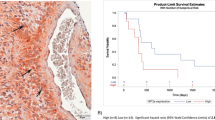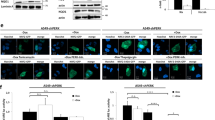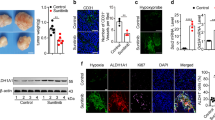Abstract
Tumor hypoxia negatively regulates cell growth and causes a more malignant phenotype by increasing the expression of genes encoding angiogenic, metabolic and metastatic factors. Of clinical importance, insufficient tumor oxygenation affects the efficiency of chemotherapy and radiotherapy by poorly understood mechanisms. The hypoxia-inducible factor (HIF)-1 is a master transcriptional activator of oxygen-regulated genes and HIF-1 is constitutively upregulated in several tumor types. HIF-1 might thus be implicated in tumor therapy resistance. We found that transformed mouse embryonic fibroblasts deficient for HIF-1α are more susceptible to the treatment with carboplatin, etoposide and ionizing radiation than wild-type cells. Increased cell death in HIF-1α-deficient cells was because of apoptosis and did not involve p53 induction. Tumor chemotherapy of experimental fibrosarcoma in immunocompromised mice with carboplatin and etoposide confirmed the enhanced susceptibility of HIF-1α-deficient cells. Agents that did not cause DNA double-strand breaks, such as DNA-synthesis inhibitors or a DNA single-strand break-causing agent equally impaired cell growth, independent of the HIF-1α genotype. Functional repair of a fragmented reporter gene was decreased in HIF-1α-deficient cells. Thus, hypoxia-independent basal HIF-1α expression in tumor cells, as known from untransformed embryonic stem cells, is sufficient to induce target gene expression, probably including DNA double-strand break repair enzymes.
This is a preview of subscription content, access via your institution
Access options
Subscribe to this journal
Receive 50 print issues and online access
$259.00 per year
only $5.18 per issue
Buy this article
- Purchase on Springer Link
- Instant access to full article PDF
Prices may be subject to local taxes which are calculated during checkout






Similar content being viewed by others
Abbreviations
- DFX:
-
deferoxamine mesylate
- HIF-1:
-
hypoxia-inducible factor-1
- IC50:
-
50% inhibitory concentration
- MEF:
-
mouse embryonic fibroblast
- pVHL:
-
von Hippel–Lindau tumor suppressor protein
References
Aebersold DM, Burri P, Beer KT, Laissue J, Djonov V, Greiner RH and Semenza GL . (2001). Cancer Res., 61, 2911–2916.
Alarcón R, Koumenis C, Geyer RK, Maki CG and Giaccia AJ . (1999). Cancer Res., 59, 6046–6051.
Ali SH and DeCaprio JA . (2001). Semin. Cancer Biol., 11, 15–23.
An WG, Kanekal M, Simon MC, Maltepe E, Blagosklonny MV and Neckers LM . (1998). Nature, 392, 405–408.
Birner P, Schindl M, Obermair A, Plank C, Breitenecker G and Oberhuber G . (2000). Cancer Res., 60, 4693–4696.
Brown JM . (2000). Mol. Med. Today, 6, 157–162.
Brown JM and Giaccia AJ . (1998). Cancer Res., 58, 1408–1416.
Carmeliet P, Dor Y, Herbert JM, Fukumura D, Brusselmans K, Dewerchin M, Neeman M, Bono F, Abramovitch R, Maxwell P, Koch CJ, Ratcliffe P, Moons L, Jain RK, Collen D and Keshet E . (1998). Nature, 394, 485–490.
Comerford KM, Wallace TJ, Karhausen J, Louis NA, Montalto MC and Colgan SP . (2002). Cancer Res., 62, 3387–3394.
Epstein AC, Gleadle JM, McNeill LA, Hewitson KS, O'Rourke J, Mole DR, Mukherji M, Metzen E, Wilson MI, Dhanda A, Tian YM, Masson N, Hamilton DL, Jaakkola P, Barstead R, Hodgkin J, Maxwell PH, Pugh CW, Schofield CJ and Ratcliffe PJ . (2001). Cell, 107, 43–54.
Farinelli SE and Greene LA . (1996). J. Neurosci., 16, 1150–1162.
Gao J and Richardson DR . (2001). Blood, 98, 842–850.
Gassmann M, Kvietikova I, Rolfs A and Wenger RH . (1997). Kidney Int., 51, 567–574.
Graeber TG, Osmanian C, Jacks T, Housman DE, Koch CJ, Lowe SW and Giaccia AJ . (1996). Nature, 379, 88–91.
Griffiths JR, McSheehy PM, Robinson SP, Troy H, Chung YL, Leek RD, Williams KJ, Stratford IJ, Harris AL and Stubbs M . (2002). Cancer Res., 62, 688–695.
Hammond EM, Denko NC, Dorie MJ, Abraham RT and Giaccia AJ . (2002). Mol. Cell. Biol., 22, 1834–1843.
Hansen MB, Nielsen SE and Berg K . (1989). J. Immunol. Methods, 119, 203–210.
Harris AL . (2002). Nat. Rev. Cancer, 2, 38–47.
Höckel M, Schlenger K, Höckel S and Vaupel P . (1999). Cancer Res., 59, 4525–4528.
Höckel M and Vaupel P . (2001). J. Natl. Cancer Inst., 93, 266–276.
Höpfl G, Wenger RH, Ziegler U, Stallmach T, Gardelle O, Achermann R, Wergin M, Kaser-Hotz B, Saunders HM, Williams KJ, Stratford IJ, Gassmann M and Desbaillets I . (2002). Cancer Res., 62, 2962–2970.
Isaacs JS, Jung YJ, Mimnaugh EG, Martinez A, Cuttitta F and Neckers LM . (2002). J. Biol. Chem., 277, 29936–29944.
Ivan M, Kondo K, Yang H, Kim W, Valiando J, Ohh M, Salic A, Asara JM, Lane WS and Kaelin Jr WG . (2001). Science, 292, 464–468.
Iyer NV, Kotch LE, Agani F, Leung SW, Laughner E, Wenger RH, Gassmann M, Gearhart JD, Lawler AM, Yu AY and Semenza GL . (1998). Genes Dev., 12, 149–162.
Jaakkola P, Mole DR, Tian YM, Wilson MI, Gielbert J, Gaskell SJ, von Kriegsheim A, Hebestreit HF, Mukherji M, Schofield CJ, Maxwell PH, Pugh CW and Ratcliffe PJ . (2001). Science, 292, 468–472.
Jewell UR, Kvietikova I, Scheid A, Bauer C, Wenger RH and Gassmann M . (2001). FASEB J., 15, 1312–1314.
Jiang BH, Agani F, Passaniti A and Semenza GL . (1997). Cancer Res., 57, 5328–5335.
Jiang BH, Semenza GL, Bauer C and Marti HH . (1996). Am. J. Physiol., 271, C1172–1180.
Katschinski DM, Le L, Heinrich D, Wagner KF, Hofer T, Schindler SG and Wenger RH . (2002). J. Biol. Chem., 277, 9262–9267.
Katschinski DM, Robins HI, Schad M, Frede S and Fandrey J . (1999). Cancer Res., 59, 3404–3410.
Koukourakis MI, Giatromanolaki A, Sivridis E, Simopoulos C, Turtey H, Talks K, Gatter KC and Harris AL . (2002). Int. J. Radiat. Oncol. Biol. Phys., 53, 1192–1202.
Krieg M, Haas R, Brauch H, Acker T, Flamme I and Plate KH . (2000). Oncogene, 19, 5435–5443.
Kung AL, Wang S, Klco JM, Kaelin WG and Livingston DM . (2000). Nat. Med., 6, 1335–1340.
Lederman HM, Cohen A, Lee JW, Freedman MH and Gelfand EW . (1984). Blood, 64, 748–753.
Mabjeesh NJ, Post DE, Willard MT, Kaur B, Van Meir EG, Simons JW and Zhong H . (2002). Cancer Res., 62, 2478–2482.
Maxwell PH, Dachs GU, Gleadle JM, Nicholls LG, Harris AL, Stratford IJ, Hankinson O, Pugh CW and Ratcliffe PJ . (1997). Proc. Natl. Acad. Sci. USA, 94, 8104–8109.
Maxwell PH, Wiesener MS, Chang GW, Clifford SC, Vaux EC, Cockman ME, Wykoff CC, Pugh CW, Maher ER and Ratcliffe PJ . (1999). Nature, 399, 271–275.
Minchenko A, Leshchinsky I, Opentanova I, Sang N, Srinivas V, Armstead V and Caro J . (2002). J. Biol. Chem., 277, 6183–6187.
Mosmann T . (1983). J. Immunol. Methods, 65, 55–63.
Rapisarda A, Uranchimeg B, Scudiero DA, Selby M, Sausville EA, Shoemaker RH and Melillo G . (2002). Cancer Res., 62, 4316–4324.
Ravi R, Mookerjee B, Bhujwalla ZM, Sutter CH, Artemov D, Zeng Q, Dillehay LE, Madan A, Semenza GL and Bedi A . (2000). Genes Dev., 14, 34–44.
Ryan HE, Lo J and Johnson RS . (1998). EMBO J., 17, 3005–3015.
Ryan HE, Poloni M, McNulty W, Elson D, Gassmann M, Arbeit JM and Johnson RS . (2000). Cancer Res., 60, 4010–4015.
Seagroves TN, Ryan HE, Lu H, Wouters BG, Knapp M, Thibault P, Laderoute K and Johnson RS . (2001). Mol. Cell. Biol., 21, 3436–3444.
Semenza GL . (2000). Crit. Rev. Biochem. Mol. Biol., 35, 71–103.
Semenza GL . (2002). Trends Mol. Med., 8, S62–S67.
Vaupel P, Thews O and Höckel M . (2001). Med. Oncol., 18, 243–259.
Wang GL, Jiang BH, Rue EA and Semenza GL . (1995). Proc. Natl. Acad. Sci. USA, 92, 5510–5514.
Wanner RM, Spielmann P, Stroka DM, Camenisch G, Camenisch I, Scheid A, Houck DR, Bauer C, Gassmann M and Wenger RH . (2000). Blood, 96, 1558–1565.
Wenger RH . (2002). FASEB J., 16, 1151–1162.
Wenger RH, Camenisch G, Desbaillets I, Chilov D and Gassmann M . (1998). Cancer Res., 58, 5678–5680.
Williams KJ, Telfer BA, Airley RE, Peters HP, Sheridan MR, van der Kogel AJ, Harris AL and Stratford IJ . (2002). Oncogene, 21, 282–290.
Zhong H, De Marzo AM, Laughner E, Lim M, Hilton DA, Zagzag D, Buechler P, Isaacs WB, Semenza GL and Simons JW . (1999). Cancer Res., 59, 5830–5835.
Zundel W, Schindler C, Haas-Kogan D, Koong A, Kaper F, Chen E, Gottschalk AR, Ryan HE, Johnson RS, Jefferson AB, Stokoe D and Giaccia AJ . (2000). Genes Dev., 14, 391–396.
Acknowledgements
We thank B Stier and S Schindler for excellent technical assistance, I Desbaillets for helpful advice and W Jelkmann for support. This work was supported by grants of the FSP-Oncology, University of Lübeck (to DMK and RHW) and the Deutsche Forschungsgemeinschaft (We2672/1-1 to RHW).
Author information
Authors and Affiliations
Corresponding author
Rights and permissions
About this article
Cite this article
Unruh, A., Ressel, A., Mohamed, H. et al. The hypoxia-inducible factor-1α is a negative factor for tumor therapy. Oncogene 22, 3213–3220 (2003). https://doi.org/10.1038/sj.onc.1206385
Received:
Revised:
Accepted:
Published:
Issue Date:
DOI: https://doi.org/10.1038/sj.onc.1206385
Keywords
This article is cited by
-
Hypoxic microenvironment in cancer: molecular mechanisms and therapeutic interventions
Signal Transduction and Targeted Therapy (2023)
-
Chloroquine prevents hypoxic accumulation of HIF-1α by inhibiting ATR kinase: implication in chloroquine-mediated chemosensitization of colon carcinoma cells under hypoxia
Pharmacological Reports (2023)
-
Interfering with Tumor Hypoxia for Radiotherapy Optimization
Journal of Experimental & Clinical Cancer Research (2021)
-
Crosstalk between endoplasmic reticulum stress and oxidative stress: a dynamic duo in multiple myeloma
Cellular and Molecular Life Sciences (2021)
-
Emerging role of tumor cell plasticity in modifying therapeutic response
Signal Transduction and Targeted Therapy (2020)



